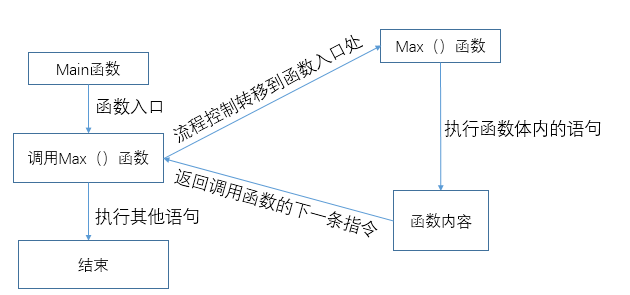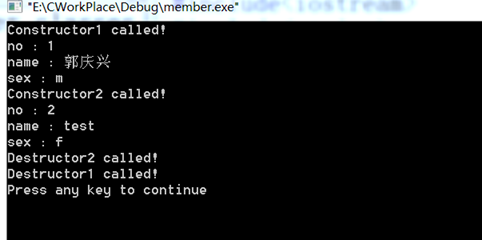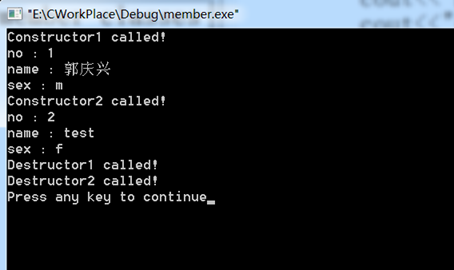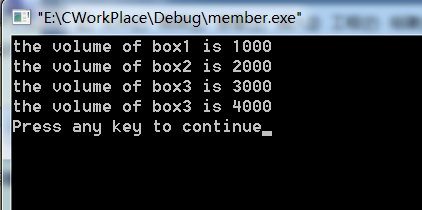C++使用类和对象
1、 内置函数
程序调用函数时需要一定的时间和空间开销,其执行过程一般如下:

而C++提供了一种高效率的方法,即在编译的时候将所调用函数的代码直接嵌入到主函数中,而不是将流程转出去,这样可以避免函数调用时频繁的转入与转出操作,从而节省过程中“保存现场”和“恢复现场”所需的时间。如下代码:
#include<iostream>
using namespace std;
inline int max(int,int,int);
int main()
{
int i=1,j=2,k=3;
int m=max(i,j,k);
cout<<"max="<<m<<endl;
return 0;
}
inline int max(int a,int b,int c){
if(b>a)
a=b;
if(c>a)
a=c;
return a;
}
内置函数虽然节省了程序的运行时间,但会增加目表函数的长度,这也是不利的,需要综合分析后使用。
2、 成员函数
如下简单案例
#include<iostream>
#include<string>
using namespace std;
class Student{
public:
void display();
void set();
private:
int num;
char sex;
string name;
};
void Student::display()
{
cout<<"num:"<<num<<endl;
cout<<"sex:"<<sex<<endl;
cout<<"name:"<<name<<endl;
}
void Student::set()
{
cin>>num;
cin>>sex;
cin>>name;
}
int main(){
Student stu;
stu.set();
stu.display();
return 0;
}
成员函数在类外定义的时候,必须在函数名前加上类名,予以限定,“::”表示作用域限定符,用它声明函数属于哪个类。
注意:如果函数在类外定义时,系统不会将其认为是加了inline的内置函数,这些成员函数的调用和普通的函数调用相同,这样有利于类的接口和类的实现相分离,利于信息的隐藏。
3、 带参数的构造方法
以一个简单的案例说明:
#include<iostream>
#include<string>
using namespace std;
class Box
{
private:
int height;
int width;
int length;
public:
Box(int,int,int);
int volume();
};
Box::Box(int h,int w,int l){
height=h;
width=w;
length=l;
}
int Box::volume()
{
return height*length*width;
}
int main(){
Box box1(12,25,10);
cout<<"the volume of box1 is "<<box1.volume()<<endl;
return 0;
}
也可以通过参数初始化表对数据成员初始化,将类中的构造方法进行改写,如下:
class Box
{
private:
int height;
int width;
int length;
public:
Box(int h,int w,int l):height(h),width(w),length(l){};
int volume();
};
注意如果类中的数据成员是数组,则应在构造函数体中用语句对其赋值,而不能在参数初始化表中对其初始化。如下案例:
class Student
{private:
int no;
char name[20];
public:
Student(int n,char nam[]):no(n){
strcpy(name,nam);};
void display();
};
void Student::display(){
cout<<no<<" "<<name<<endl;
}
int main()
{
Student stu(1,"郭庆兴");
stu.display();
return 0;
}
或者这样
class Student
{private:
int no;
string name;
public:
Student(int n,string nam):no(n),name(nam){};
void display();
};
4、 构造函数的重载
如下面一个简单的代码案例:
#include<iostream>
#include<string>
using namespace std; class Box
{
private:
int height;
int width;
int length;
public:
Box();
Box(int h,int w,int l):height(h),width(w),length(l){};
int volume();
}; Box::Box(){
height=10;
width=10;
length=10;
} int Box::volume()
{
return height*length*width;
}
int main(){
Box box1;
cout<<"the volume of box1 is "<<box1.volume()<<endl;
Box box2(12,25,10);
cout<<"the volume of box1 is "<<box2.volume()<<endl;
return 0;
}
注意:当建立对象使用无参构造函数函数时,要注意语句的书写:
Box box1;
而不能写成:
Box box1(); //错误
以上错误的语句并不是定义Box对象,而是定义一个返回为Box的普通函数。
5、 使用默认参数构造函数
如下案例:
#include<iostream>
#include<string>
using namespace std;
class Box
{
private:
int height;
int width;
int length;
public:
Box(int h=10,int w=10,int len=10):height(h),width(w),length(len){};
int volume();
void display();
};
int Box::volume()
{
return height*length*width;
}
int main(){
Box box1;
cout<<"the volume of box1 is "<<box1.volume()<<endl;
Box box2(12,25);
cout<<"the volume of box2 is "<<box2.volume()<<endl;
Box box3(12,25,30);
cout<<"the volume of box3 is "<<box3.volume()<<endl;
return 0;
}
因此在编写设有默认参数的构造方法的时候,不可以有两个构造方法,如下:
Box(int h=10,int w=10,int len=10);
Box();
这样如果一旦执行“Box box;”,系统就不能分别是以哪个构造方法为基准建立构造函数。
6、 析构函数
析构函数是一个特殊的成员函数,它的名字是类名前面加上“~”符号。在C++中“~”是取反运算符。可以联想到它是与构造函数起相反的作用。析构函数的作用是在撤销对象占用的内存之前,完成一些清理工作。
析构函数不返回任何值,没有函数类型,也没有函数参数。由于没有函数参数,因此它并不能重载,即一个类只能有一个析构函数。
如下案例:
#include<iostream>
#include<string>
using namespace std; class Student
{private:
int no;
string name;
char sex;
public:
Student(int n,string nam,char s){
no=n;
name=nam;
sex=s;
cout<<"Constructor"<<no<<" called!"<<endl;
}
~Student(){
cout<<"Destructor"<<no<<" called!"<<endl;
}
void display(){
cout<<"no : "<<no<<endl;
cout<<"name : "<<name<<endl;
cout<<"sex : "<<sex<<endl;
}
}; int main()
{
Student stu1(1,"郭庆兴",'m');
stu1.display();
Student stu2(2,"test",'f');
stu2.display();
return 0;
}
结果如图所示:

可知,对于构造函数,程序先执行stu1的构造函数,再去执行stu2的构造函数;而对于析构函数来说,程序先执行stu2的析构函数,再去执行stu1的析构函数,这就十分类似于栈的特性了。对于“同一级别”的构造函数个析构函数是这样的,那么不同“级别”,则不是这样的,这里以局部变量和全局变量来举例。如下代码:
int main()
{
Student stu1(1,"郭庆兴",'m');
stu1.display();
static Student stu2(2,"test",'f');
stu2.display();
return 0;
}
在stu2对象前面加上一个static即可,此时stu2是静态变量,它一直到程序全部运行结束后才会释放。结果如下图:

7、 对象数组
数组不仅可以存放简单变量,还可以存放由类组成的对象。如下案例:
#include<iostream>
#include<string>
using namespace std;
class Box
{
private:
int height;
int width;
int length;
public:
Box(int h=10,int w=10,int len=10):height(h),width(w),length(len){};
int volume();
void display();
};
int Box::volume()
{
return height*length*width;
} int main(){
Box a[4]={
Box(),
Box(20),
Box(10,30),
Box(10,10,40)
};
cout<<"the volume of box1 is "<<a[0].volume()<<endl;
cout<<"the volume of box2 is "<<a[1].volume()<<endl;
cout<<"the volume of box3 is "<<a[2].volume()<<endl;
cout<<"the volume of box4 is "<<a[3].volume()<<endl;
return 0;
}
结果如图所示:

C++使用类和对象的更多相关文章
- Java编程里的类和对象
像我们搞计算机这块的,都知道这么一件事,当前的计算机编程语言主要分为两大块,一为面向过程,二为面向对象.Java就是一门纯面向对象的语言.学习了一个月左右的Java,在下对于Java当中的类和对象有了 ...
- Python - 类与对象的方法
类与对象的方法
- C++基础知识(5)---类和对象
终于把C++中的基础在前面的几篇博客中总结完了,可能还有一些语法还没有总结到,没关系,以后用到了再查资料就好.类是C++中的一个非常重要的概念,这是区别你使用的C++到底是面向过程还是面向对象的一个重 ...
- 简述JavaScript对象、数组对象与类数组对象
问题引出 在上图给出的文档中,用JavaScript获取那个a标签,要用什么办法呢?相信第一反应一定是使用document.getElementsByTagName('a')[0]来获取.同样的,在使 ...
- 前端学PHP之面向对象系列第一篇——类和对象
× 目录 [1]类 [2]成员属性[3]成员方法[4]对象[5]成员访问[6]this 前面的话 面向对象程序设计(OOP)是一种计算机编程架构.计算机程序由单个能够起到子程序作用的单元或对象组成,为 ...
- Objective-C Runtime 运行时之一:类与对象
Objective-C语言是一门动态语言,它将很多静态语言在编译和链接时期做的事放到了运行时来处理.这种动态语言的优势在于:我们写代码时更具灵活性,如我们可以把消息转发给我们想要的对象,或者随意交换一 ...
- [Java入门笔记] 面向对象编程基础(一):类和对象
什么是面向对象编程? 我们先来看看几个概念: 面向过程程序设计 面向过程,是根据事情发展的步骤,按进行的顺序过程划分,面向过程其实是最为实际的一种思考方式,可以说面向过程是一种基础的方法,它考虑的是实 ...
- 解析Java类和对象的初始化过程
类的初始化和对象初始化是 JVM 管理的类型生命周期中非常重要的两个环节,Google 了一遍网络,有关类装载机制的文章倒是不少,然而类初始化和对象初始化的文章并不多,特别是从字节码和 JVM 层次来 ...
- 02OC的类和对象
这章重点介绍OC的类以及对象,由于C语言是面向过程语言,而OC只是对于C语言多了一些面向对象的特性,所以OC相对于其他面向对象语言,例如C#.Java等没有那么多的语法特性,所以差别还是比较大的. 一 ...
- swift基础:第六部分:类与对象
http://reactnative.cn/docs/0.24/getting-started.html#content(react Native 开发文档) 互联网这个时代,你松懈一天,就会有很多很 ...
随机推荐
- JSP 知识基本
from:http://blog.csdn.net/caipeichao2/article/details/38589293 more:http://www.2cto.com/kf/web/jsp/4 ...
- 初探linux子系统集之led子系统(一)
就像学编程第一个范例helloworld一样,学嵌入式,单片机.fpga之类的第一个范例就是点亮一盏灯.对于庞大的linux系统,当然可以编写一个字符设备驱动来实现我们需要的led灯,也可以直接利用g ...
- LeetCode(60)-ZigZag Conversion
题目: The string "PAYPALISHIRING" is written in a zigzag pattern on a given number of rows l ...
- LeetCode(51)- Count and Say
题目: The count-and-say sequence is the sequence of integers beginning as follows: 1, 11, 21, 1211, 11 ...
- Linux下安装MQ
1.下载Linux下MQ的安装包,网上下载试用版或购买正版,此处以7.0.0.0版为例安装 2.如上图所示,是linux的MQ安装包展开图 3.创建用户和用户组 >root用户连接linux & ...
- iOS解决UITableView中Cell重用带来的问题
tableView的常规配置,当超出一屏的cell就会标上可重用的标识出列到可重用缓存池中,后面再根据可重用标识来到的可重的cell就会和前面显示同样内容. - (UITableViewCell *) ...
- access窗体主体居中
Private Sub Form_Load()DoCmd.Echo False Dim x, y As IntegerDoCmd.Maximizex = Me.WindowWidthy = Me.Wi ...
- git merge 与 rebase
git merge git rebase merge V.S. rebase 参考材料 写在开始: 对merge和rebase的用法总有疑惑,好像两个都能完成"获取别的branch的comm ...
- node.js代理设置
1.设置代理 npm config set proxy=http://proxy.tencent.com:8080 设置代理服务器,比如:npm config set proxy=http://127 ...
- python笔记:#010#运算符
运算符 目标 算数运算符 比较(关系)运算符 逻辑运算符 赋值运算符 运算符的优先级 数学符号表链接:https://zh.wikipedia.org/wiki/数学符号表 01. 算数运算符 是完成 ...
